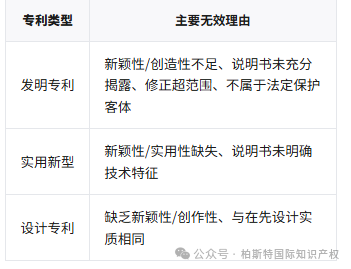- Knowledge
Preface
The patent invalidation system in Taiwan adopts a binary structure of "administrative filing as the main and judicial confirmation as the auxiliary", with the core procedure being administrative review by the Intellectual Property Office (TIPO) of the Ministry of Economic Affairs, which can be followed by administrative litigation. The following are the key points and comparative analysis with the mainland system:
1、 Legal Framework and Process
1. Core legal basis
Patent Law (Latest Revision: 2022)
Intellectual Property Case Trial Law (Establishment of Professional Courts)
Management Organization: Intellectual Property Office of the Ministry of Economic Affairs (TIPO)
2. Core program: Patent filing (administrative procedure)
【 Application filed by the applicant 】 - 【 TIPO formal examination 】 - 【 Notification to the patentee for defense 】 - 【 TIPO substantive examination 】 - 【 Establishment of the application, revocation of all/part of the patent rights 】 - 【 Establishment of the application, maintenance of the patent rights 】 - 【 Administrative litigation if the parties are dissatisfied 】
3. Key features:
Pre administrative procedure: Invalidation must be declared through the TIPO procedure (similar to mainland China, different from direct litigation in Hong Kong).
Judicial review: Administrative litigation is under the exclusive jurisdiction of the Intellectual Property and Commerce Court (IPC Court) (in mainland China, it is under the jurisdiction of the Beijing Intellectual Property Court).
2、 Key rules of the reporting procedure
1. Reason for complaint(Articles 71, 119, 141 of the Patent Law)

Special restrictions:
The publication should be based on specific evidence (such as comparative documents, use of public proof).
The same patent right cannot be repeatedly cited with the same evidence and reasons (to avoid procedural abuse).
2. Program flow
Deadline:
Defense period: 1-3 months (extendable by 2 months) after the patentee receives the notice.
TIPO review cycle: an average of 12-18 months (can be extended for complex cases).
Rules of Evidence:
Non Chinese evidence needs to be accompanied by a traditional Chinese translation (translation costs account for 30% -50% of the publication cost).
Accept evidence from outside the jurisdiction (such as USPTO/EPO search reports), but require notarization and authentication.
Parallel program:
In infringement litigation, the defendant can file a lawsuit, and the court usually suspends the infringement trial (similar to the handling of "civil and administrative cross-over" in mainland China).
3、 Judicial review stage
1. Jurisdiction and Procedure
Exclusive jurisdiction: Intellectual Property and Commerce Court (IPC Court) first instance → Supreme Administrative Court final instance.
Review criteria:
Focus on legal application and procedural legality (without reviewing new evidence in principle).
Exception: New evidence may be accepted if it proves that the TIPO decision is clearly incorrect.
Cycle:Administrative litigation takes an average of 1.5-2 years.
4、 Comparison of Patent Invalidation Systems Across the Taiwan Strait

5、 Practical Strategies for Enterprises
1. Key techniques for reporting procedures
Evidence combination: For invention patents, priority should be given to using the combination of "comparative document 1 common knowledge" to attack creativity.
Program Assault: Simultaneous filing of infringement lawsuits, forcing patent holders to engage in dual line combat.
Amendment restriction: The patentee may limit the scope of the claims during the defense (without expanding the scope).
2. Success rate data (2019-2023)

Note: The court revision rate refers to the proportion of TIPO decisions overturned by the judiciary.
6、 Special scenario handling
1. Parallel operation across the Taiwan Strait is invalid
Strategy Selection:
If the patent is registered in both mainland China and Taiwan at the same time, priority should be given to initiating invalidation in mainland China (with short cycle and low cost).
Invalid decisions from the mainland can be used as evidence in Taiwan (requiring notarization and traditional Chinese translation).
Risk statement
The Taiwan court strictly accepts evidence from the mainland and requires authentication from the Straits Exchange Foundation.
2. Coping with industrial differences
Electronics/Semiconductors: Emphasize technical feature comparison and make good use of TIPO's TW Patent Search system.
Pharmaceutical patents: rely on the authenticity examination of experimental data, and the issuer can request TIPO to retrieve the drug certificate approval documents.
7、 Trends in institutional development
1. Digital acceleration:In 2023, the electronic petition system will be implemented (reducing the time for correspondence by 30%).
2. Cross Strait cooperation:Simplify the authentication process of official documents through the Cross Strait Agreement on Intellectual Property Protection Cooperation.
3. Judicial professionalization:Expand the investigative power of technical examiners in patent litigation (strengthened by the 2022 amendment).
Suggestions for Enterprise Action:
For high-risk patents: pre layout anti invalid designs (such as retaining research and development experiment logs, third-party certification reports).
Response to claims: The patentee should shorten the claims and supplement the implementation data within the defense period.




